Run-of-river power plants on the Glatt
The run-of-river power plants on the Glatt used the water of the Glatt from Greifensee ( 436 m above sea level ) 38.5 kilometers downstream through the Zürcher Unterland to the confluence ( 335 m above sea level ) with the Rhine at Rheinsfelden almost continuously.
Early industrialization
The relatively steep gradient in the lower reaches of the Glatt from Niederglatt ( 418 m above sea level ) was already used economically in the Middle Ages to operate water mills . From the 15th century, the city of Zurich exercised sovereignty over the Glatt (1462 Glattordnung in the city register). In the 16th century the council delegated the supervision of the river to two so-called Glattvögte. In 1593 the first attempt to correct the meandering Glatt was made. In the 17th century, attempts were made to prevent the frequent floods, which often caused damage to the waterworks, by straightening the river between Wallisellen and Oberglatt.
In 1807 there were 13 mills from Greifensee to the Rhine. From 1816 onwards, the industrial use of hydropower emerged, primarily through spinning mills. Mechanical power generation was switched from water wheels to the more efficient turbines in the second half of the 19th century.
The great floods through the Glatt in 1876, 1878 and 1881 led to the fact that the Zurich law on river corrections was adopted in 1876 and the river was continuously corrected between 1878 and 1895 with the help of the federal government.
The smooth corrections made it possible to increase to 18 waterworks by 1900, eight of which were mills as well as spinning mills, twisting mills, weaving mills and the Herrenwies power plant in Hochfelden.
From 1890 the turbines were fitted with generators and the mechanical energy was replaced by electricity. Around 1900 the waterworks for electricity generation on the lower Glattlauf reached an output of 1500 kW.
In 1936, the law on lowering the Glatt created the conditions for a definitive remedy against flooding. The lowering of the river from Niederglatt to its confluence took place between 1975 and the early 1980s. After the Niederglatt-Rhein correction in 1975, the waterworks disappeared for good.
History of hydropower in the Zürcher Unterland
The Greifenseewuhr Society was founded in 1890 as an interest group for water rights owners on the Glatt. It was converted into a cooperative in 1937 and dissolved in 1980. In 1891 she had a regulating weir built at the Glatt runoff, with which the lake could be dammed by one meter when the tide was low. By correcting the Glatt and the weir, the mean level of the lake was lowered by around 80 centimeters. The discharge should be 2 m³ per second when the water level is low, so that the industrial companies on the Glatt could have sufficient water in dry times.
The Obere Mühle in Dübendorf (Oberdorf) was first mentioned in 1368. In 1821, today's mill building was built on the site of the previous building. 13 years later the still existing water wheel was added. In 1962 the mill was shut down for financial reasons. The building complex consisted of the main house, the mustard mill, the old smith, the utility building and the barn that burned down in 1978. Since 1990 the mill has been operated as a cultural center by the Obere Mühle Foundation.
The listed lower mill Birchlen in Dübendorf (Unterdorf) was built in 1806 and in 1836 the newly built “old Homberger spinning mill” (previously Hanhart) was built on the other side of the smooth. The mill is of a Birchlen Zuppingerrad (m ∅ 4.20, width 4.50 m) is driven. In 1864 the government council allowed the owner Homberger & Cie. Instead of the previous four water wheels (two on the left on the canal for the mill, the third on the right for the threshing machine, the fourth above right on the canal for the saw), a single large water wheel next to the mill building.
The chemical plant flora AG started in 1900 to manufacture in Dübendorf fragrances and was renamed Esrolko AG 1945th In 1948 Givaudan bought the flavor manufacturer Esrolko.
The silk and cotton twining mill Zwicky & Co in Neugut, Wallisellen (1840–2001), and the Herzogenmühle, also located on the Glatt canal, formed the cornerstones of Wallisellen's industrialization. From 1851 a new, expanded factory sewer was built in order to be able to use the water power of the Glatt. Glatt and Chriesbach supplied the operation of Zwicky & Co with energy by means of a turbine. The lowering of the Glatt due to the highway construction in 1973 led to the loss of hydropower in the Neugut.
The Herzogenmühle, first mentioned in 1293 (1817–1923, belonging to Wallisellen since 1894) formed an important and economically significant part of the manorial power of the Grossmünsterstift in Schwamendingen. In the 18th century, thanks to the well-developed water power of the Glatt, the company was expanded to include a sawmill, grinding shop, hemp and flax pounding shop and a tobacco factory. After the fire of 1808 it was converted into a cotton mill and later a fabric dyeing and printing plant was set up. With the death of the last manufacturer, Emil Zuppinger, operations were stopped in 1923. In 2009, the Herzogenmühle Wasserkraft AG commissioned a small power plant with a medium-sized water wheel (5.2 meters in diameter, 2.6 meters in height), which can supply 30 households with 150,000 kWh of green electricity per year.
The Opfikon mill was located a little outside the village of Opfikon towards the Glatt and was connected to the Fronhof mentioned in 1325. The waterwheel was fed by a side stream of the Glatt and a pond connected to it.
The Glattbrugg mill was first mentioned in 1303. After the smooth correction was completed in 1890, turbines replaced the old mill wheels and served the Lehner rayon spinning mill from 1894 to 1912 and the Hauser carpet factory from 1912 to 1970 .
The Oberglatt mill was bought by the State of Zurich in 1817 as part of a Glatt correction. Because it had a negative effect on the water level of the Glatt, it was canceled.
The Hofstetten mill belonged to the Lords of Rümlang in the 14th century. It was also bought by the state around 1817. He had the mill rebuilt, lowered its slope and built new water channels next to the mill, before selling it again. At the same time, the smooth bed from Hofstetten to Niederglatt was re-excavated.
The Rümlang mill served as a grain and wage mill, saw, hemp grater, oil and roller. In the middle of the mill canal was the eel room, where eels were washed up when the miller opened the locks. In the 18th century, eels from the Glatt were exported as a delicacy to the Viennese court. In the 19th century, the mill and sawmill were the most important employers in the village. In 1908 the Rümlang electricity works cooperative was founded. The mill burned down in 1911 and the sawmill was abandoned after World War II .
The Augustinian monastery Sankt Martin am Zürichberg (Zürich-Fluntern) bequeathed the Niederglatt mill to the miller Ulrich Folkhart as a fiefdom in 1411 and helped him financially with the reconstruction. Folkhart undertook to build two functioning mills and a roller with a mill house, wheels, millstones, a chain and a Wuhr.
The cotton merchant J. G. Blum from Winterthur bought the Oberhöri spinning mill in 1835 . The turbine house was built on the Glatt in 1874. The spinning mill was acquired by the Blumer spinning mill in Freienstein in 1889. In 1892 an electric turbine from Rieter was installed. The canals were filled in in 1979 and the turbine house was demolished in 1986.
The Jakobstal spinning mill (1819–1983) settled on the Glattlauf near Bülach . In 1889 it was bought by the Blumer spinning mill in Freienstein.
The Hochfelden cotton twining mill was built and electrified in Hirslen, Hochfelden in 1868 (closed in 1962). The Hirslen sawmill used to stand there and was driven by the smooth water via mill wheels.
The Martinsmühle in Hochfelden was acquired by the Cistercian monastery Wettingen in the 13th century . With the smooth correction from 1975 to 1981, in which the river bed was shifted 100 m to the east, the village center was redesigned.
The first power plants were planned by the Zurich engineer Conrad Arnold around 1889 on the Glatt (Burenwisen and Herrenwies). The concessions were granted by the canton in 1889 and the municipality of Bülach in 1891.
In 1890 the Society for the Utilization of Water Power was founded at Glatt AG , Herrenwies. The first Herrenwies power plant in Hochfelden used a 12 meter gradient. The water from the Glatt was diverted north of Hochfelden into a canal, which was used to generate electricity in the Herrenwies power station on the edge of the forest of the Strassberg west of the Glatt. The second factory in Herrenwies supplied electricity to the Oerlikon machine factory from 1890 to 1910 via an overland line . In 1916 the electro-chemical industry in Herrenwies emerged (from 1940 the Stüdli brothers made synthetic resin, which produced "Bakelite").
The Burenwisen power plant in Glattfelden used a 7-meter gradient and supplied electricity to Bülach for the first time in 1891. The Gesellschaft für Elektrizität AG in Bülach, founded in 1896, later sold the plant to EKZ. The power plant was shut down in 1976. Today it is the Stromhaus EKZ Museum.
The Spinnerei und Weberei AG (SWG) in Glattfelden owned by the Syz family in Zurich, who owned a large weaving mill in Dietikon, was built on a former miller's site. This included the spinning mill on Strickstrasse built in 1855 and the weaving mill that was built in 1867. The weaving mill was closed in 1981, the spinning mill in 1983. The J. Salzmann-Däniker cotton twining mill was built in 1896 (closed in 1964).
The Glattfelden light and power plant cooperative, founded in 1898, took over the Gloor mill. Instead of the old mill wheel, two Rieter turbines with 20 and 30 hp supplied electricity for the threshing machine, mill, sawmill, street lighting and house installations from 1899 onwards.
The Letten yarn spinning mill was established in Zweidlen (Glattfelden) in 1865 . She had to stop production in 2006. In the workshop building (Assekuranz-Nr. 345) there was a triple Francis turbine to turbine the water flow of 4.5 m³.
Hydroelectric power plants from Greifensee to the mouth of the Rhine
Legend: ID = water law, cat. = Gross gradient, type = output in megawatts
| ID | photo | object | Cat. | Type | address | Coordinates |
|---|---|---|---|---|---|---|
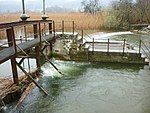
|
Regulatory defense of the Greifenseewuhr Society in 1891 | Greifensee |
691923 / 247593
|
|||
| 1 |

|
Upper mill Dübendorf 1368, 1821 | 1.1 | Dübendorf (Oberdorf) |
689498 / 250063
|
|
| 4th |

|
Lower mill Birchlen 1806 | Dübendorf (Unterdorf) |
688819 / 250533
|
||
| 89 |

|
Flora chemical factory, Esrolko, Givaudan 1900 | Dubendorf |
688508 / 250639
|
||
| 196 |
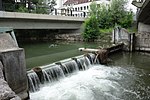
|
"Hochbord" weir with fish ladder, Grindelweier water intake and Herzogenmühle factory canal | Giessen, Wallisellen |
688147 / 250708
|
||
| 99 |
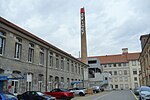
|
Factory plant Neugut Zwicky & Co | Neugutstrasse, Wallisellen |
687823 / 251025
|
||
| 95 |

|
Herzogenmühle 1293, 1817–1923, small power station 2009 | 2.6 | Wallisellen |
686128 / 251772
|
|

|
Opfikon Mill, Fronhof 1325 | Opfikon |
685573 / 253995
|
|||
| 70 |

|
Glattbrugg mill 1303, Lehner art spinning mill 1894–1912, Hauser carpet factory 1912–1970 | Glattbrugg |
684861 / 254337
|
||

|
Hofstetten mill 14th century | 1.9 | Hofstetten |
680647 / 259583
|
||
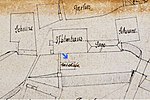
|
Rümlang mill | Rümlang |
682794 / 256492
|
|||

|
Mill 1411 | Niederglatt |
680345 / 260611
|
|||

|
Spinning mill Oberhöri 1835, turbine house 1874–1986 | Oberhöri |
679775 / 261765
|
|||
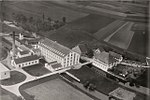
|
Jakobstal spinning mill 1819–1983 | Bülach / Hochfelden |
681711 / 263400
|
|||
| 57 |
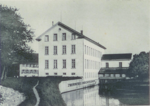
|
Hochfelden twisting mill | Hirslen, Hochfelden |
681647 / 264073
|
||
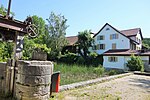
|
Martinsmühle 13th century | Hochfelden |
681224 / 264208
|
|||
| 55 |
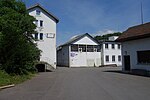
|
Herrenwis electricity works 1889, 1890–1910, Gebrüder Stüdli 1940 | 12 | In the capture, Bülach |
681509 / 266195
|
|
| 36 |
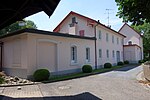
|
Burenwisen electricity works 1891–1976, EKZ museum | 7th | Glattfelden |
681586 / 266926
|
|
| 41 |

|
Glattfelden spinning mill 1855–1983 | Strickstrasse, Glattfelden |
679958 / 267736
|
||
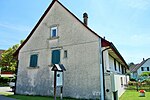
|
Glattfelden mill 1254, 1625 | Gottfried-Keller-Strasse 35-39, Glattfelden |
679724 / 268001
|
|||
| 42 |
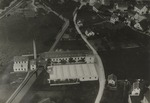
|
Glattfelden weaving mill 1867–1981 | Glattfelden |
679661 / 268116
|
||
| 44 |

|
Salzmann-Däniker cotton twisting mill 1896–1964 | Glattfelden |
679534 / 268325
|
||
| 43 |

|
Mill Gloor, Cooperative for Light and Power Plant Trucks 1898 | Glattfelden |
679476 / 268277
|
||
| 52 |
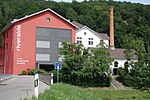
|
Letten spinning mill 1865–2006 | Zweidlen, Glattfelden |
678373 / 269269
|
Exhibition Stromhaus Burenwisen EKZ, Glattfelden
The Stromhaus houses an exhibition of historical and modern exhibits and current electricity information. Electrical equipment and technical equipment from the past 100 years can be viewed. Experiments in the electricity laboratory and a slide show provide practical insight and knowledge transfer.
literature
- Jakob Tuggener : 50 years of stock corporation Spinnerei & Weberei Glattfelden 1893-1943. Festschrift 1943/44. Album with 139 mounted photo prints.
- Albert Mossdorf : The industry of the Zurich Unterland. In: Neujahrsblatt für Bülach and the Zürcher Unterland 1947. Published by the Bülach Reading Society, Bülach 1947.
- Urs Zimmermann, Charlotte Kunz, Kurt Bolt, Heidi Dütsch-Schmid: Cotton and hydropower. How the textile industry came to the lower Glattal. In: Neujahrsblatt der Reading Society Bülach. No. 32, Bülach 1988.
- Ulrich Pfister: The Zurich Fabriques, proto-industrial growth from the 16th to the 18th century. Chronos Verlag, Zurich 1992.
- Hans-Peter Bärtschi: Industrial culture in the canton of Zurich. Rotpunktverlag, Zurich 1994, ISBN 978-3-85869-407-2 .
- Walo Ludescher: Glattfelden spinning and weaving mill 1854–1983. Company chronicle compiled from memory. Glattfelden 2008.
Web links
- NZZ of November 28, 2006: Small power station on the Glatt feasible
- SRF Einstein from January 31, 2013: Old technology - new concepts: Renaissance for the water wheel
Individual evidence
- ^ Geographical Lexicon of Switzerland. 1902.
- ↑ State Archives Zurich StAZ: Smooth logs 16th to 18th centuries, Archives of Greifenseewuhr cooperative.
- ↑ That's us. History. In: Website of the Upper Mill Dübendorf.
- ^ State Archives of the Canton of Zurich 1864
- ↑ Züri Ost from March 18, 2008: Flavors for the whole world
- ↑ Tages-Anzeiger from July 19, 2010: High-tech company - or stink factory
- ^ Givaudan Dübendorf AG, 2000: 100 years of Givaudan in Dübendorf. A century for smell and taste
- ↑ The Herzogenmühle. In: Website of the local museum Schwamendingen.
- ↑ Neulandforum from November 25, 2015: The new power of water
- ↑ Works Supply Wallisellen AG: Electricity - made in Wallisellen ( Memento of the original from September 20, 2018 in the Internet Archive ) Info: The archive link was inserted automatically and has not yet been checked. Please check the original and archive link according to the instructions and then remove this notice.
- ↑ Tages-Anzeiger of August 21, 2009: Wallisell electricity is becoming more expensive
- ↑ Sisre Magazine for Science, Research and Engineering March 2009: Small hydropower plant Herzogenmühle on the net ( page no longer available , search in web archives ) Info: The link was automatically marked as defective. Please check the link according to the instructions and then remove this notice.
- ^ History. The coming and going of the sexes. In: Website of the municipality of Opfikon.
- ^ Isabell Hermann: Fronhof and Mühle zu Opfikon. New Year's Gazette 1999, Opfikon municipality
- ^ Opfikon history: Glattbrugg mill
- ↑ State Archives Zurich: Properties of the artificial silk factory Lehner. Site plan Glatt area No. 57
- ^ History of the community of Oberglatt and Elektrohof. In: Website of the municipality of Oberglatt.
- ↑ Zurich State Archives: Purchase of the Hofstetten mill in 1881
- ↑ Trapped in the eel room. In: Website of the Department of Culture of the Canton of Zurich on the anniversary year 1998 «150 Years of the Federal State».
- ↑ Awarding of the mill in Niederglatt and help with the reconstruction. 1411. State Archives of the Canton of Zurich.
- ↑ Urs Zimmermann, Charlotte Kunz, Kurt Bolt, Heidi Dütsch-Schmid: Cotton and water power. How the textile industry came to the lower Glattal. In: Neujahrsblatt Bülach. No. 32, 1988.
- ^ Hochfelden municipality. History. In: Website of the community of Hochfelden.
- ↑ Municipality of Bülach from November 2, 2014: Inquiry regarding the old Jakobstal spinning mill with images
- ^ Bülach postcards: Hochfelden
- ^ Landscape change: Hochfelden
- ^ Bülach postcards: 1890 Society for the utilization of water power at Glatt AG, Herrenwies
- ↑ EKZ: Stromhaus Burenwisen
- ^ Hans-Peter Pflüger: Industrial textile production in the late 20th century in Switzerland and Germany. The shrinkage process based on case studies. Diss. Univ. Constance 2015 (PDF; 4.47 MB).
- ^ History. In: Website of the Glattfelden light and power plant.
- ↑ Bruno Meier: 120 Years of the Light and Power Plant Cooperative (1). Far-sighted men saw the future of the river. In: The Glattfelder. March 22, 2018, p. 15 (PDF; 10.49 MB).
- ↑ Bruno Meier: 120 Years of the Light and Power Plant Cooperative (2). The electricity pioneers had some tough nuts to crack. In: The Glattfelder. April 19, 2018, p. 13 (PDF; 10.62 MB).
- ↑ Bruno Meier: 120 Years of the Light and Power Plant Cooperative (3). Independence through electricity supply contract with the EKZ. In: The Glattfelder. May 3, 2018, p. 14 (PDF; 10.22 MB).
- ^ Riverside Zweidlen-Glattfelden: History
- ↑ Zürcher Unterländer of April 22, 2018: A visit to the Stromhaus provides topics of conversation


